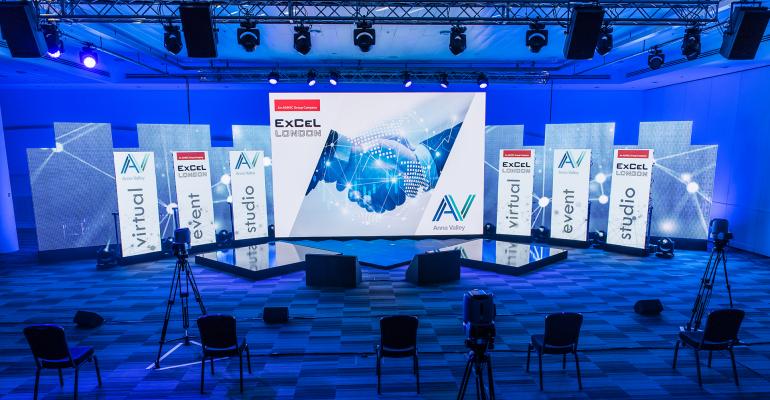Before he spoke at the SeneGence International virtual conference last week in Tulsa, Okla. Meetology’s Jonathan Bradshaw tweeted a revealing video clip from behind the scenes at the Cox Business Convention Center. He showed off the broadcast stage: a semicircle of 20-foot-high plasma screens that he called “one of the most incredible virtual set-ups I’ve ever seen.”
Convention centers like Cox, hard hit by the pandemic in 2020, may have an outsized role to play for virtual and hybrid conferences going forward. While virtual meetings over the spring and summer were focused on quick transitions from face-to-face, planners now have more time to invest in an event’s production values and to consider hybrid options, armed with a better understanding of how social distancing, masks, and good ventilation can keep small groups safe.
Convention centers not only have relatively open calendars, large spaces available for stage set-ups and social distancing, and production-company relationships in place, they’re also creating broadcast-ready spaces to make the virtual or hybrid experience more turnkey and more professional looking. The trend this fall is for convention centers to build out permanent virtual/hybrid meeting studios featuring high-definition broadcasting equipment, high-end lighting, and graphics and video tools. Here are eight such options:
• ExCeL London opened its new virtual event studio on October 15 in partnership with production company Anna Valley. Located above the venue’s main event halls, the studio has a digital backdrop, multiple cameras, and a full sound system and lighting rig. Up to 30 delegates can be accommodated in person.
• Baltimore Convention Center, working with its in-house production company Projection, rolled out its broadcast studio in late summer, producing programming for the International Association of Exhibition and Events’ CEM Week, held virtually August 24-28.
• In late August, Houston’s George R. Brown Convention Center opened the Avenida Houston Virtual Studio, a permanent 5,250-square-foot studio for virtual events with or without an in-person audience. The broadcast studio boasts a Biodefense air-filtration system.
 • In Singapore, Marina Bay Sands launched a hybrid event broadcast studio in August at its Sands Expo and Convention Centre. (left) With space for 50 people in the audience, the studio offers broadcast-quality livestreaming, right-angled LED walls, and a plexiglass LED floor for an immersive experience. The studio's holographic telepresence abilities allow planners to “beam” speakers onto the stage.
• In Singapore, Marina Bay Sands launched a hybrid event broadcast studio in August at its Sands Expo and Convention Centre. (left) With space for 50 people in the audience, the studio offers broadcast-quality livestreaming, right-angled LED walls, and a plexiglass LED floor for an immersive experience. The studio's holographic telepresence abilities allow planners to “beam” speakers onto the stage.
• Manhattan’s riverside convention facility, the Jacob K. Javits Center, opened a 30,000-square-foot broadcast studio in September that can host up to 300 participants in a socially distanced setting. The Nest Summit was the first virtual event to use the space.
• In September, Events DC unveiled a new 19,000-square-foot production studio at the Walter E. Washington Convention Center, equipped with rigging, audiovisual and lighting capabilities, and LED screens. At the same time, it introduced a virtual platform called GATHER where livestreamed events can be viewed online.
• When Seattle’s Washington State Convention Center reopened in late September for groups of up to 200 attendees, the venue announced that along with new safety guidelines it had also developed a virtual-event studio.
• In October, the 1,400-seat Ferrara Theater at America’s Center in St. Louis was reintroduced as StreamStage for hybrid meetings. The rental space comes with a production manager, internet bandwidth for live streaming, an HD camera, a studio backdrop with lighting, projection, and audio capabilities.





